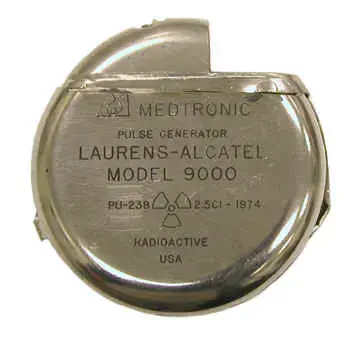In today’s episode of “weird shit I stumbled onto on the internet”, I bring you: nuclear-powered pacemakers.

Some of the earlier pacemakers made in the US, around the 70’s, were powered by a very small amount of plutonium. If you’ve ever heard of the term radioisotope thermoelectric generator or RTG in relation to eg. satellites, that’s what the pacemakers used. The upside of using an RTG was that the device could run for decades without needing to get its power source replaced. The downside is that you now have plutonium sown in to your chest cavity – which actually isn’t as bad as it sounds considering the amounts used, but it’s still a highly radioactive element and presents some fun challenges, some of which are discussed in the article.
Here’s an article on the technical details on how they, and thermoelectric kajiggers in general, work https://blog.plover.com/tech/seebeck-effect.html
So there were people with a synthetically produced element powering there hearts (for decades), and none of them made flying mech suits in all that time?
They didn’t have boxes of scraps laying around… otherwise it absolutely would have happened.
I wonder why no new companies have picked up this technology. Some patients surviving 30 years, with no surgical intervention required is a pretty bold claim for any pacemaker. Regulations be damned.
Regulations be damned.
I guess when it comes to plutonium the US Nuclear Regulatory Commission doesn’t want to take any chances – it’s still frickin’ plutonium after all. But yeah, having a pacemaker that’ll essentially work the rest of the patient’s life sounds pretty damn impressive, although I really don’t know what the state of the art is.
But if we do want to sew radionuclides into people (because why not), maybe the same could be done with one that’s a bit less spicy? I’d imagine that with modern technology you could get away with using something that wouldn’t give you the same amount of power, but that also wouldn’t be… well, plutonium.
Other fuels would either require much more shielding or have a much shorter life. Plutonium-238 lasts for decades and barely produces any gamma radiation.
Yeah that makes sense, and I guess it figures that they didn’t originally pick plutonium just for shits and giggles
Lol, let’s just be glad this didn’t become wide spread enough to tempt a certain boy scout to turn serial killer.
Would have made for a pretty crazy story though 😅
I got to wondering what happened to David Hahn, and it turns out he died of an OD in 2016. He was apparently doing a lot of coke and was ‘paranoid about people who he claimed “had the ability to ‘shock’ his genitals with their minds”’, and around 2007 he decided it’d be a great idea to steal a bunch of smoke detectors for, well, something.
So his real story didn’t end nearly as happily as I’d hoped
and was ‘paranoid about people who he claimed “had the ability to ‘shock’ his genitals with their minds”’
Some people really need to gjve their kids more sex education instead of leaving them in the dark to work it all out for themselves.
But he likely had paranoia or something like that, education won’t much help you there 😁 even the smartest person can suddenly start believing pretty weird things
I wish I remembered the details, but I read a couple years ago about new batteries using the same sort of principal.
It was being studied as a way to handle a specific part of radioactive byproduct from nuclear power.
You sandwich the tiny radioactive bit in materials to generate a charge, and the whole thing is encased in conductive man-made diamond.
A battery the size of a half dollar coin could generate roughly a watt of power for, ostensibly, up to hundreds of years.
The big seller beyond its lifespan is that the diamond is dense enough to shield the tiny amount of radiation inside.
Incredible potential that probably wont be realized in consumer goods for decades. Just think about never having to change the battery in a remote ever again. Or even a lot of wireless smart home sensors and devices.
A shocking amount of things take very little power. Air tags that never die. E-book readers. You could make super dim puck LEDs that are always on and can go anywhere for illuminating pathways.
You could never scale it much in size/output because the diamond encasing would become disproportionately heavy and expensive, but for anything 1.5 Watts and less, and possibly up to 3 Watts or so, could be totally feasible.
to put that into some interesting context that’s about what your cell phone uses if you go through the battery over 24hrs. With a battery or big capacitor to act as an accumulator you could in theory have a smart phone that never needs charging, or rarely when you use it a lot in one night.
This article poses the idea of a universal smartphone battery.
Remember when we could just remove and swap the battery? Now we could go back to that, removing the part where we charge it and the battery just… does it.
Not quite there yet, but holy hell this looks far more promising than most things we get. The idea of getting away from cell batteries entirely is… momentous.





